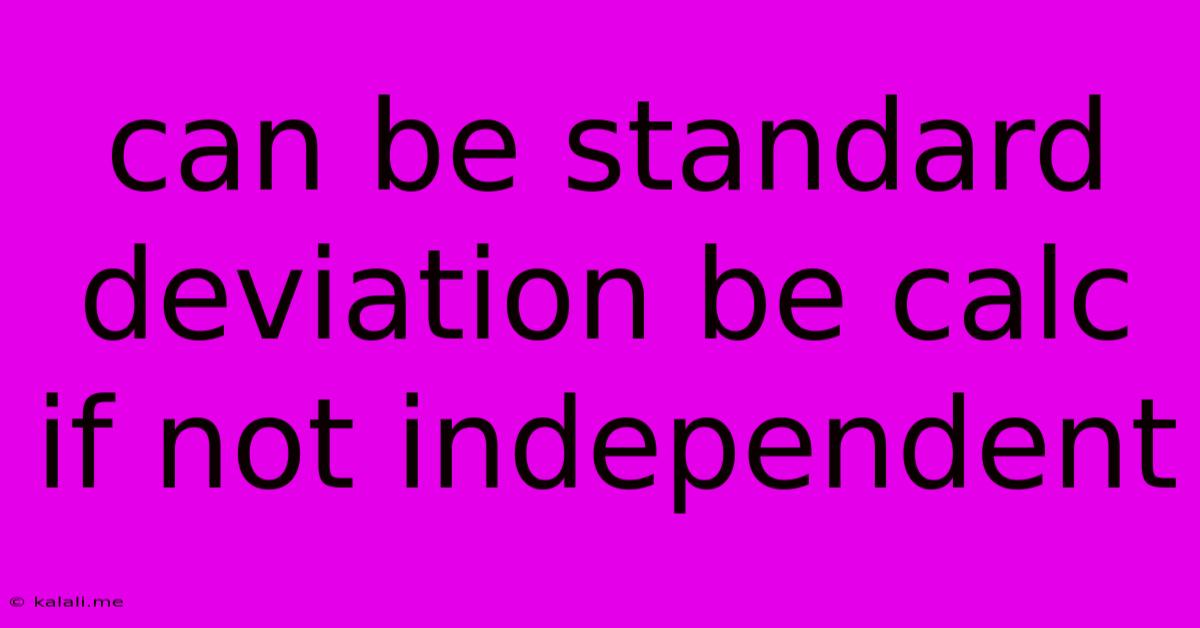Can Be Standard Deviation Be Calc If Not Independent
Kalali
Jun 08, 2025 · 3 min read

Table of Contents
Can Standard Deviation Be Calculated If Data Points Are Not Independent?
The short answer is: yes, you can calculate a standard deviation even if your data points are not independent, but the interpretation and use of that standard deviation change significantly. This article explores why independence matters, how non-independence affects standard deviation calculations, and what alternatives might be more appropriate.
What is Standard Deviation and Why Does Independence Matter?
Standard deviation measures the spread or dispersion of a dataset around its mean. It quantifies how much individual data points deviate from the average. The standard formula assumes independence, meaning that the value of one data point doesn't influence the value of another. This assumption is crucial for the validity of many statistical inferences based on the standard deviation.
When data points are independent, the standard deviation accurately reflects the inherent variability within the data. However, when independence is violated (e.g., in time series data, clustered data, or data with autocorrelation), the calculated standard deviation can be misleading. It may underestimate or overestimate the true variability. This is because the dependencies between data points introduce additional structure that isn't captured in the standard calculation.
Consequences of Ignoring Non-Independence
Calculating the standard deviation with non-independent data can lead to several problems:
- Inaccurate Confidence Intervals: Standard deviation is often used to construct confidence intervals. If the data isn't independent, the confidence interval will be incorrectly sized – too narrow (giving a false sense of precision) or too wide (leading to less power in statistical tests).
- Invalid Hypothesis Tests: Many statistical tests rely on the assumption of independence. Using a standard deviation from non-independent data in these tests will lead to incorrect p-values and potentially flawed conclusions.
- Misleading Variability Estimates: The standard deviation will not accurately reflect the true variability in the population because the dependencies inflate or deflate the apparent spread.
Handling Non-Independent Data: Alternatives to Standard Deviation
Several approaches are available when dealing with non-independent data, depending on the nature of the dependence:
- Time Series Analysis: For time series data (e.g., stock prices, temperature readings), techniques like autoregressive integrated moving average (ARIMA) models or generalized autoregressive conditional heteroskedasticity (GARCH) models are better suited than simply calculating the standard deviation. These models explicitly account for the temporal dependencies within the data.
- Generalized Estimating Equations (GEE): GEE is a powerful method for analyzing data with clustered or correlated observations. It allows for the estimation of parameters while accounting for the within-cluster correlation. The standard errors obtained from GEE are more appropriate than the standard deviation calculated from the raw data.
- Mixed-Effects Models: Similar to GEE, mixed-effects models are useful for data with hierarchical structures (e.g., repeated measurements on the same individuals). They incorporate random effects to account for the correlation between observations within clusters.
- Accounting for Autocorrelation: If the dependence is due to autocorrelation (correlation between data points separated by a certain time lag), techniques like Newey-West standard errors can provide more accurate standard errors.
Conclusion:
While the standard deviation calculation itself remains possible with non-independent data, it's crucial to understand that the resulting value doesn't accurately reflect the true variability. Ignoring non-independence can lead to inaccurate statistical inferences. Therefore, always carefully consider the nature of your data and employ appropriate statistical methods that explicitly account for any dependencies present. The choice of method depends on the specific type of dependence structure in your data. Understanding the nature of your data and its dependencies is the first, and most critical step.
Latest Posts
Latest Posts
-
How To Heat A Frozen Burrito
Jun 09, 2025
-
How To Kill The Wither Easily In The End
Jun 09, 2025
-
How To Attach Casters To Metal Legs
Jun 09, 2025
-
What Does Econ Mean On Ac
Jun 09, 2025
-
How Old Are Romeo And Juliet In The Play
Jun 09, 2025
Related Post
Thank you for visiting our website which covers about Can Be Standard Deviation Be Calc If Not Independent . We hope the information provided has been useful to you. Feel free to contact us if you have any questions or need further assistance. See you next time and don't miss to bookmark.